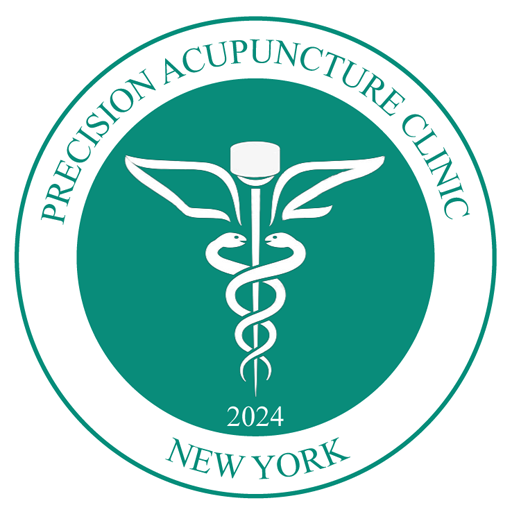How can acupuncture reduce the pain?
As an ancient treatment of Traditional Chinese Medicine (TCM) for various clinical symptoms, acupuncture is one of the most commonly used alternative therapies for effective pain management worldwide. More patients are adopting acupuncture treatment for pain relief.
With the help of modern medical research, not only has a large body of research articles validated the positive therapeutic effects of acupuncture for chronic pain disorders, such as low back pain, knee osteoarthritis, headache, and shoulder pain, but also we now have a better understanding of the mechanisms of acupuncture in reducing pain. Here, we would like to communicate our comprehensive clinical experience in treating various pain symptoms and the published acupuncture research literature with our patients on the possible mechanisms by which acupuncture can be a wise treatment choice for patients’ pain management.
Acupuncture provides versatile stimulation at peripheral tissues
In human organ systems, it is often divided into central system and peripheral system. For instance, the human nervous system consists of the central nervous system (CNS), namely the brain and spinal cord, and the peripheral nervous system (PNS) that includes all other nervous tissue throughout the body. Similarly, the cardiovascular system has a central component, the heart, and a peripheral component, the blood vessels. As to the anatomical part of the immune system, the lymphatic system is also made of two components: the central lymphoid organs of the thymus and bone marrow, and the peripheral lymphoid organs and tissues of lymph nodes, the spleen, and other lymphoid tissues.
Acupuncture treatment is mainly carried out by inserting a filiform fine needle into the tissue at various acupuncture points, called acupoints. Acupoints can be divided into two major types: 1) points on the classical meridians and extra points not on the meridians that have a relatively fixed location and 2) random Ashi acupoints that are determined based on the tenderness or symptoms of each patient. Moreover, those acupoints are roughly divided into local points, at or around the site of injury, and distal points, located far away from the anatomical body parts. Please refer to Fig. 1 for an example of clinically commonly used acupoints in shoulder pain management.
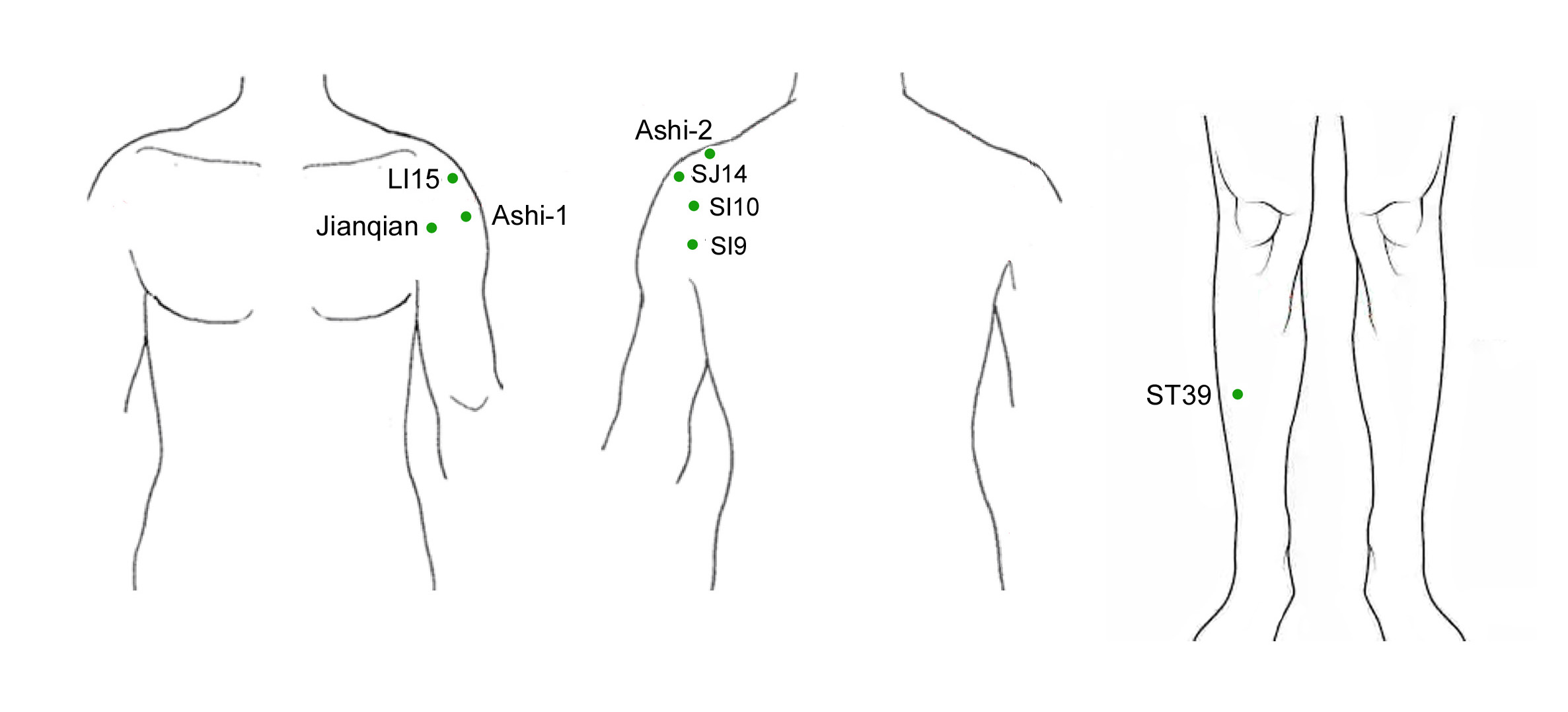
Fig. 1. An example of some acupoints used for treating left shoulder pain. This example treatment uses the following different points: 1) Local points on classical meridians, called meridian acupoints: LI15, SJ14, SI9, and SI10; 2) Local points not on classical meridians, called extra acupoints: Jianqian; 3) Points that have a random location based on palpating tenderness, called Ashi acupoints: Ashi-1 and Ashi-2; and 4) Distal points: ST39.
Apparently, acupuncture needling engenders a stimulation of the peripheral tissue, such as the skin, connective tissue under the skin, muscles, tendons, ligaments, and bones. Amazingly, such a tissue stimulation has various forms: from gentle touch at the acupuncture points on the skin, to shallow insertion of the needle without manipulation, to deep needle insertion with needle manipulation. Variation also exists in the nature of the stimulation: from mechanical needle insertion to electrical current conducted into the tissue through the inserted needles, to thermal heating via moxibustion. Those various acupuncture styles enable acupuncture to treat different clinical symptoms. For example, moxibustion is very useful for treating joint pain and infertility as it can provide heat to deep tissues, while electroacupuncture is a powerful tool to treat neuromuscular pain. Those different depths and intensities of stimulation are illustrated in Fig. 2.
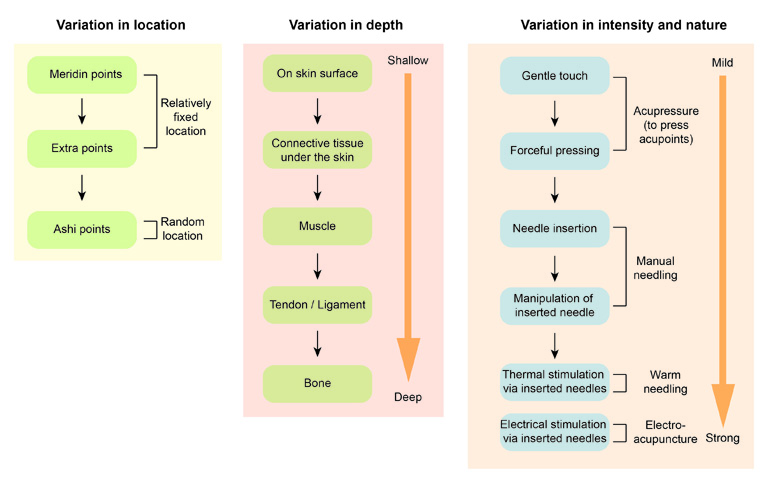
Fig. 2. Various styles of acupuncture.
Local effects to promote tissue repair
Pain is associated with tissue damage, either existing or potential. Thus, if the tissue damage underlying the pain is removed or repaired, the pain shall disappear. For this reason, clearing and repairing the pathological tissue damage may be the most beneficial clinical outcome that acupuncture treatments can achieve. Acupuncture can achieve this treatment goal by the following approaches (Fig. 3).
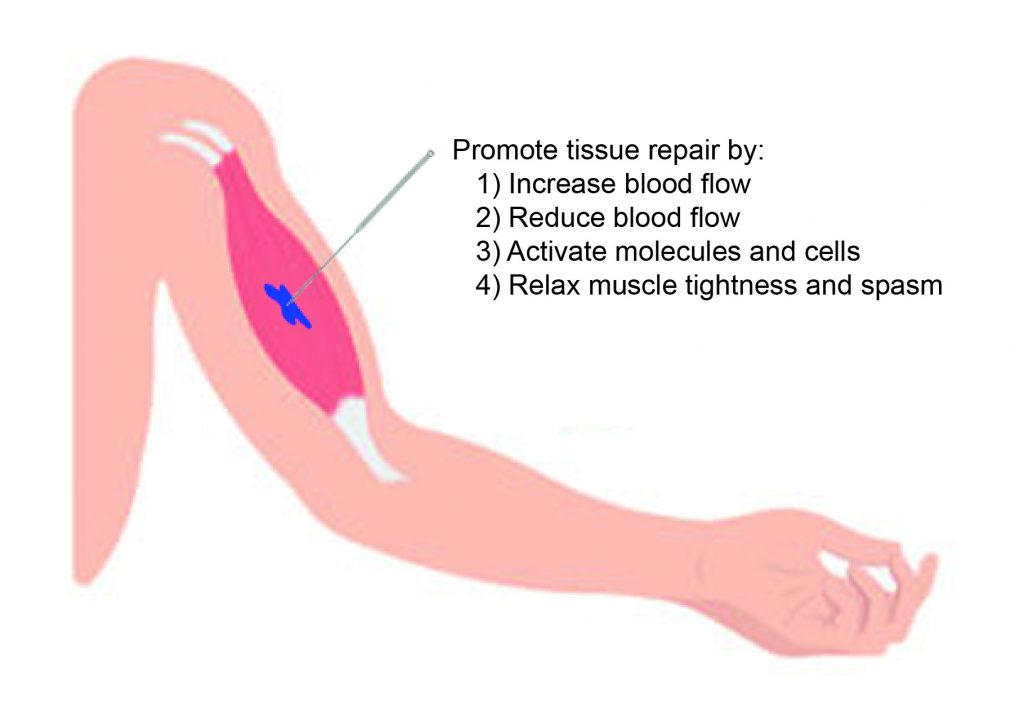
Fig. 3. Acupuncture can deliver therapeutic effects for local tissue repair.
1) To increase blood flow into the damaged tissue area: Increased blood flow to the injured tissue, especially in the capillaries, can provide fresh nutrient molecules and immune cells that are important to clear the existing noxious stimuli and enhance tissue repair. Those intrinsic repair responses and mechanisms, which consist of coordinated cardiovascular, nervous, and immune systems and are activated or enhanced by the acupuncture needling stimulation, can reach the best scenario of a therapy: remove damaged tissue and repair the tissue to its original, normal condition.
2) To reduce reduced blood flow: For certain pathological tissue changes, acupuncture can relieve the pain by decreasing the blood flow into the damaged area. This may reduce the intensity of the ongoing pain-causing process, such as blood stagnation or acute inflammation that relies on the immune cells or pro-inflammatory factors from the blood, thereby yielding alleviated pain for patients. Once such pathological conditions are reduced, tissue repair can then be initiated. If the tissue is repaired later, long-term pain relief can be achieved.
3) To activate local molecules and cells: Electroacupuncture applies a weak electric current to deep tissue through the inserted needles to promote the movements of charged ions, molecules, and cells; the latter can lead to enhanced, expedited tissue repair, which in turn may solve the cause of the pain. Similarly, but through a different mechanism, moxibustion can deliver heat into deep tissue, transferring energy to ions, molecules, and cells to boost their activities for tissue repair.
4) To relax muscle tightness and spasm: Certain neuropathy pains are due to the entrapment and compression of the nerve by muscle spasm or tension. In this case, acupuncture needling can serve to trigger muscle relaxation, which in turn can free the nerve from compression, such as in piriformis entrapment syndromes and thoracic outlet syndrome. The nerves can then recover from the previous pathological conditions.
The above does not include all the local effects that can be led by acupuncture. For example, acupuncture needling can also cause local analgesia, which will be discussed later.
Clinically, those mechanisms for tissue repair work more rapidly for acute pain as the tissue damage may be new and temporary, while it may take a longer time to repair a long-standing tissue damage that causes chronic pain. This is probably because the repair of chronic tissue damage takes a longer time and more effort, as the needling-induced response may only be able to achieve repair to a certain degree with one treatment session. Indeed, studies have shown that treatments of 3 times a week yielded better pain relief than once a week for chronic knee osteoarthritis; and a treatment course of at least 5 weeks showed maximum relief of neck pain, shoulder pain, low back pain, and knee pain. Thus, for chronic pain, it is essential to adhere to a regular acupuncture treatment, such as once or twice a week, and keep the regular treatments uninterrupted over several weeks to a couple of months to achieve cumulative therapeutic effects.
Local effects of analgesia
Studies have shown that the local extracellular level of a neuromodulator called adenosine has increased upon acupuncture stimulation. The increased adenosine can act on adenosine A1 receptor to exert an analgesic effect. The release of anti-nociception molecules is likely due to the microinjury caused by needling, which stimulates cells, such as fibroblasts, to release ATP that can be degraded into adenosine, as well as the recruitment of immune cells from increased blood flow. Those immune cells, such as lymphocytes, macrophages, and granulocytes, can also release endogenous opioids to inhibit nociception.
Systemic effects to regulate the nervous system and other organ systems
Research shows that acupuncture can stimulate a change in the autonomic nervous system (ANS) and central nervous system (CNS), including the spinal cord and brain, within seconds or minutes, a fast nervous response. For example, studies have shown that electroacupuncture can trigger a significant increase in b-endorphin, an endogenous opioid neuropeptide produced naturally in our body with an analgesic effect, in the hypothalamus, which is an essential part of the brain and plays a vital role in regulating pain. Brain imaging studies have also confirmed changes in neuroplasticity in the somatosensory cortex due to electroacupuncture stimulation at the peripheral extremities. Furthermore, the b-endorphin level has been shown to be increased in the cerebrospinal fluid and bloodstream after electroacupuncture. Collectively, those findings support a mechanism in which acupuncture treatment can affect the production of certain neurotransmitters at the systemic, whole body level. Finally, such systemic effects are not limited to endorphin, as changes in the levels of other important molecules, such as the inflammatory factor prostaglandin E2 (PGE2) and the intestine-regulating neurotransmitter serotonin, have been found either in the bloodstream or in the intestinal mucosa.
Thus, it is the current scientific understanding that acupuncture needling at the peripheral tissue can conduct the needling-generated nervous signals to the CNS, first the spinal cord and then the brain, in a peripheral-to-central approach. Once the CNS is activated in different ways, the regulation of the whole body organ systems can be achieved via the efferent system of the PNS in a CNS-to-PNS manner. Indeed, studies have shown that the peripheral stimulation of acupuncture needling can cause physiological changes in multiple organ systems, such as the spinal cord, brain, heart, stomach, intestines, and bone marrow. This is particularly important as it provides the theoretical paradigm on how acupuncture can treat symptoms of distal locations and visceral internal organs.
The following are the possible mechanisms by which acupuncture can modulate the nervous system at different levels to influence the whole body (Fig. 4).
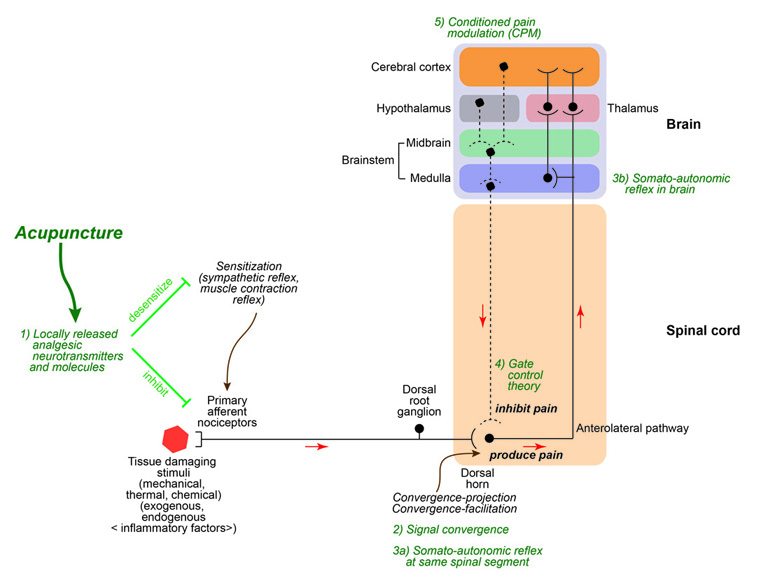
Fig. 4. Acupuncture needling at peripheral tissues can exert therapeutic effects at the local damaged tissue and in distal organs and tissues via regulating the CNS.
1) Locally released analgesic neurotransmitters and molecules, as a result of acupuncture needling, can inhibit the primary afferent nociceptors and desensitize the sensitization of the sympathetic reflex and muscle contraction reflex, thereby reducing the pain signal transmitted from the periphery nociceptors. This may be important for patients with chronic pain as studies have revealed increased sympathetic activity and reduced parasympathetic activity in patients with chronic pains, such as neck pain, shoulder pain, low back pain, and fibromyalgia, as well as in patients with irritable bowel syndrome (IBS).
2) Stimulation by acupuncture needling can produce a nervous signal to the dorsal horn of certain spinal cord segment where such a signal can converge with the pain signal from the damaged tissue, producing a converged signal projection to the brain to affect the perception of the pain;
3) Stimulation by acupuncture needling can produce a nervous signal that causes a somato-autonomic reflex to regulate multiple organ systems via the ANS at two different levels: a) somato-autonomic reflex at the same spinal segment, and b) somato-autonomic reflex in the brain;
4) The gate control mechanism can be activated by acupuncture needling to close the “gate” at the substantia gelatinosa (SG) in the dorsal horn of the spinal cord, which consists of neurons that transmit peripheral neural impulses from the peripheral sensory neurons to the brain, leading to the blockage of the transmission of pain signals to the brain. Opiate receptors have been shown to play a role in inhibiting pain-transmission interneurons of the spinal cord segment.
5) Conditioned pain modulation (CPM), characterized by reduced pain perception of a noxious stimulation at one body location caused by another pain stimulation at a distant body location, can also be activated by acupuncture needling.
Acupuncture as part of integrative medicine
Acupuncture exerts its therapeutic effects mainly through regulating the various body organ systems to activate our intrinsic disease-defense mechanisms and tissue-repair activities. Thus, it is logical that acupuncture may not achieve satisfactory clinical improvement in certain conditions of diseases or symptoms even after fully activating the intrinsic body mechanisms. Hence, it is always advised to seek medical treatment from primary and specialized doctors as needed. Such a combination of well-researched, evidence-based conventional medicine and complementary therapies, such as acupuncture, is now called integrative medicine and widely recognized in the medical field.
At Precision Acupuncture Clinic, we strive to provide high-quality acupuncture treatments that are supported by our extensive clinical experience and the cutting-edge published clinical research results to achieve the best possible pain management for our patients.
